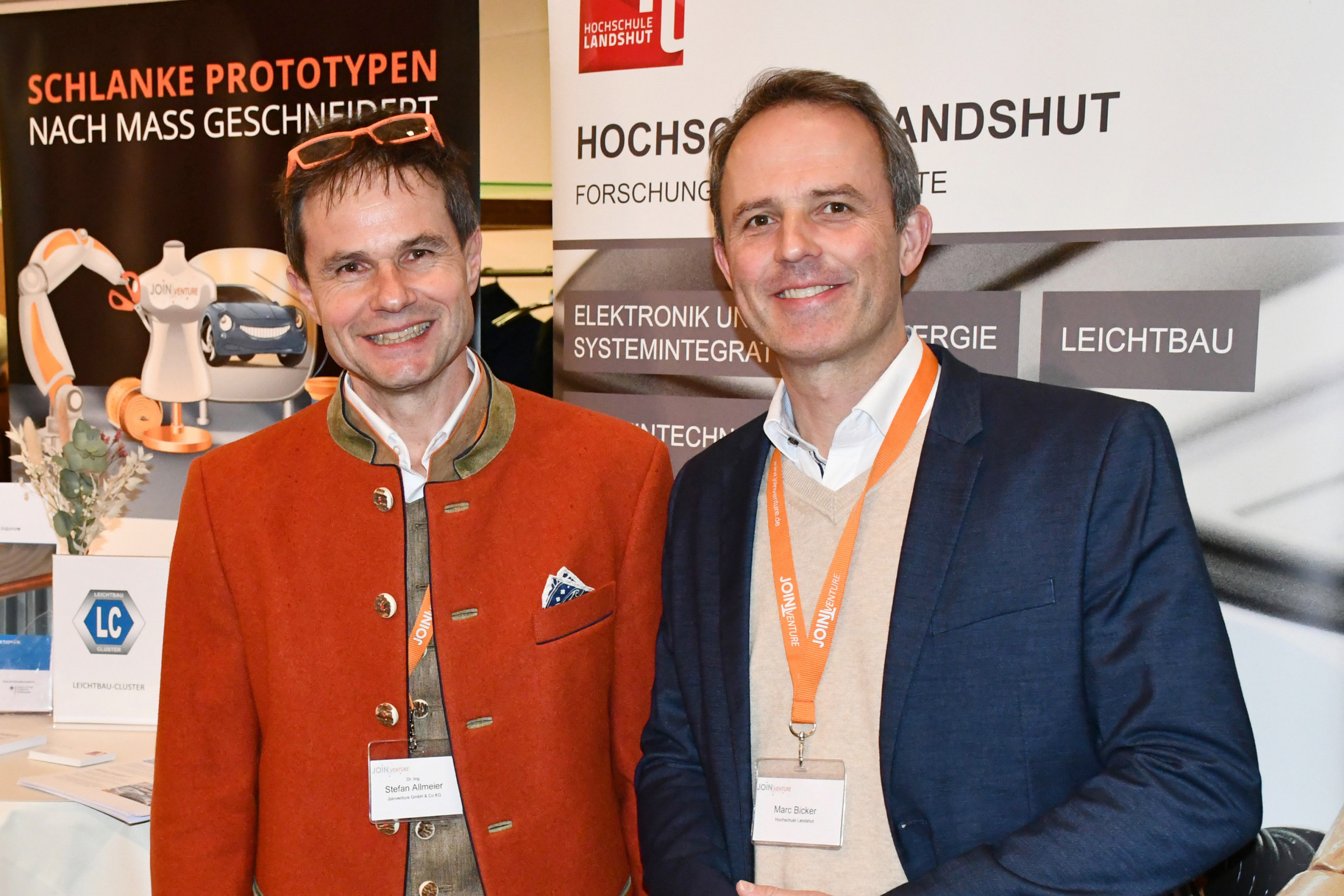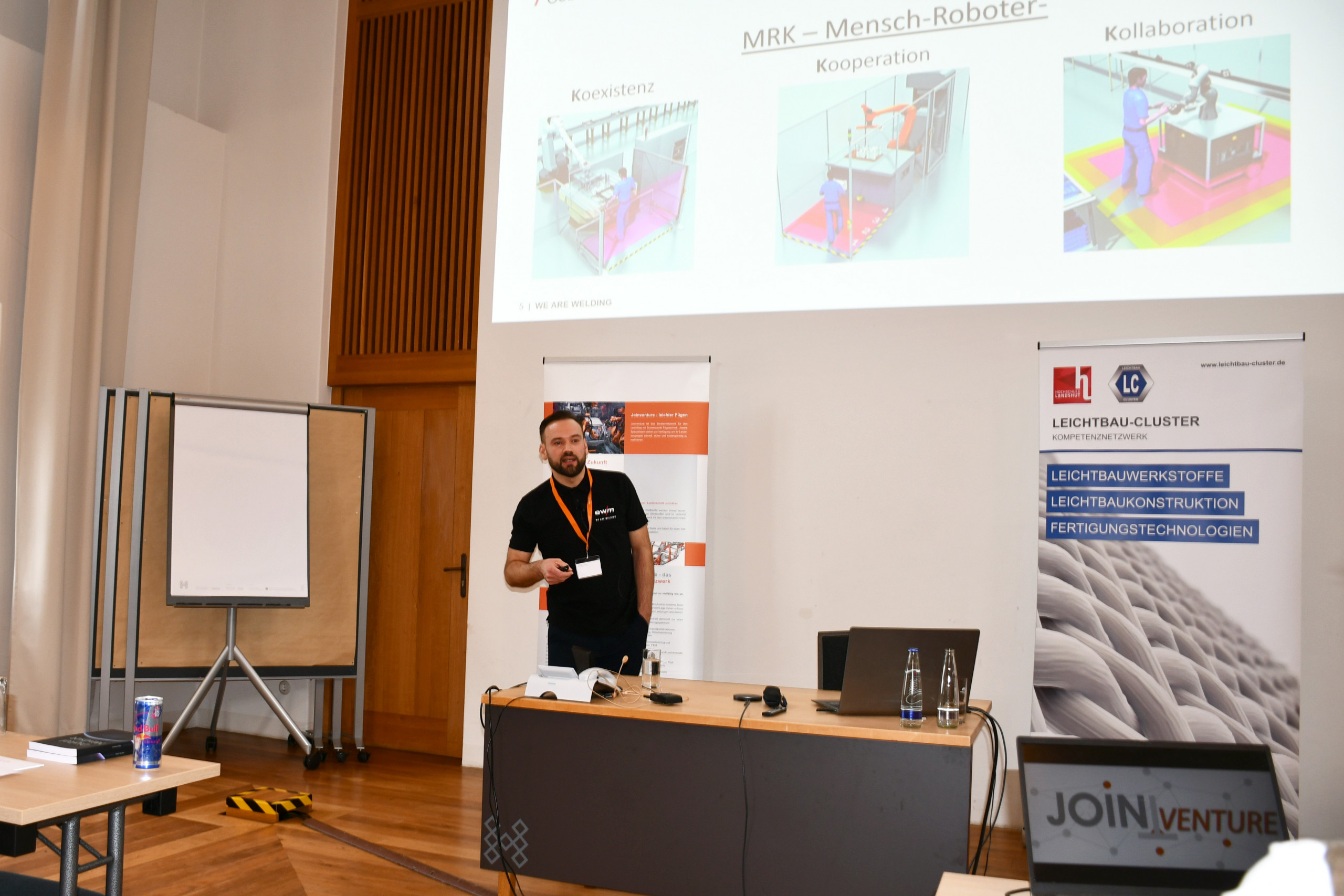
The 9th Joinventure Lightweight Construction Workshop in cooperation with the Lightweight Construction Cluster at Landshut University of Applied Sciences offered around 80 participants a wide range of topics relating to digitalization, production, welding technology and metal processing.

In 2024, the Joinventure consultancy network for lightweight construction with a focus on joining technology once again organized the biennial lightweight construction workshop together with the lightweight construction cluster at Landshut University of Applied Sciences. The 9th event in the series was held under the motto “Welding technology in lightweight construction”. It covered a wide range of topics: from the use of AI and cyber security in SMEs to cobot systems and new developments in welding systems, aluminum welding consumables, thin sheet metal clamping, metallic 3D printing and its simulation as well as the importance of material data.
Digitalization is creating new opportunities, but also challenges, when it comes to welding and metal processing, as event initiator Stefan Allmeier (Joinventure GmbH & Co. KG) emphasized in his welcoming address. That is why this year’s program, with a total of ten presentations, also focused on cyber security, AI and cobot systems in addition to the many other topics.
Digitalization and AI create opportunities – but caution is advised

© Landshut University of Applied Sciences
Using machine learning to identify the quality of welding seams and change parameters, using AI to automatically write emails such as job application rejections, having a bot answer questions or detecting skin cancer: digitalization and AI are creating new opportunities for SMEs in particular – but also new risks, especially in the area of cyber security. This was the subject of Florian Laumer (Passion4IT GmbH) in his opening speech. The quality of attacks on IT – and therefore blackmail, espionage, data theft and data encryption – is increasing sharply.
Instead of easily transparent emails, a social engineer with the support of AI, which also uses data from public profiles, is now behind the attacks. The consequences range from supply chain disruptions and production downtime to telephone instructions with the voice of the Board of Management. Even if the main gateway is well secured via IT security, the mistake of one user – similar to a faulty weld seam – is enough to exploit a vulnerability. Florian Laumer calls on people to use secure passwords or a password manager and to be very careful when disclosing information.
When training machine learning, a lot of data or photos are required, for example to detect defects in a weld seam. Here, too, he advises paying attention: data must be interpreted correctly. For example, a husky was identified as a wolf because snow could be seen in the background of all the photos. A culture of error is an important point here. You can learn a lot from mistakes and the corresponding training data. For him, AI offers enormous opportunities if you understand it, find the right use cases and thus contribute to optimization in the company.
Cobots in production

© Landshut University of Applied Sciences
Two further presentations dealt with innovations in welding technology with cobot systems. Marco Köhler (Lorch Schweißtechnik GmbH) emphasized that automation in welding has been working for some time. The topic of collaborative robots, so-called cobot systems, is currently in high demand. Humans and robots work together in direct interaction without an enclosure or safety fence. He sees advantages here for SMEs and small series, as the systems are also helpful in the face of a shortage of qualified welders.
The cobots also enable controlled, traceable processes and measurable quality. The process becomes more stable and can be tracked. Operation must be simple and quick to learn. With its Cobotronic software, Lorch has developed its own solution with new functionalities: For example, if you specify an approximate starting point, the Cobot automatically finds the weld seam to be processed via a seam search and tracking with laser line hardware. Programming is done by moving the arm. The reference point or waypoints can be customized. SeemTracking makes it possible to track the weld seams. Currently, a cobot has been mounted on a linear axis, creating a larger installation space in which several components can be welded one after the other. The basic requirement for the successful use of a cobot is to integrate it into existing processes with manual welding and industrial robots.
Dimitrij Feller presented the current developments of cobots at EWM GmbH. He emphasized that when using cobots, the general conditions, the dangers for the human employee at the entire workplace (especially the wire end and electrode, high temperatures or smoke emissions during welding) must also be considered. A cobot is slower than a robot and can currently handle a payload of 30 kg. The cobot’s control system is easy to learn and must include the power source, interface, wire feeder, cobot and robot torch components. The in-house flexible XQBOT solution is a cost-effective way to get started with modernization: Different variants can be selected, such as wire feed integrated, modular or double (once for manual welding, once for the cobot). The company also offers industry-standard cells or cobots with a higher output rate.
Challenges for newcomers with cobots include precision in preparation and fixture construction. The motivation must be to increase productivity and parts output while improving the quality of the seams. However, patience is required.
Not every task is suitable for cobots; depending on the application, a mix of manual processing and automation makes sense. Additional assistance functions could be used via additional software.
Current welding systems and special features for aluminum
Mario Hoppe (Fronius Deutschland GmbH) explained the possibilities of current welding systems using the iWave Multiprozesss Pro welding system as an example. It offers the greatest possible flexibility: one device is sufficient for the TIG, MIG/MAG and MMA welding processes. The system can also be upgraded, is ready for Industry 4.0 and can be networked. The next step is to make the system robot-compatible.
The “WeldCube Navigator” offers a wide range of assistance: The welder is guided through tasks step by step, the correct welding sequence is defined and parameters are ensured and standardized. In the event of faults at safety-relevant seams, the power source can be blocked automatically based on predefined behavior. This is achieved through live monitoring, which can be integrated into the workflow. Central documentation of the welding data with management, statistics and analysis functions as well as central user management offer a compact package.
Robert Lahnsteiner (Migal.Co GmbH) provided insights into the special features of aluminum welding and the use of aluminum welding rods. Welding steel and aluminum is very different. With steel, you weld in the cold material, the heat spreads faster due to the high conductivity of aluminum, so the parameters have to be adjusted. The melting temperature of oxides is far higher than that of aluminum, oxides remain as inclusions in the metal and do not float to the surface as with steel.
Different welding consumables must be used for different aluminum alloys, depending on whether optimum mechanical properties, corrosion resistance or weldability are required. Welding rods with more oxide on the surface have been developed for very clean, oxide-free sheets; temperature and humidity fluctuations can also cause problems. Vacuum packaging is just as helpful for the wires as storing the metal under constant conditions. Migal.Co offers a dew point calculator on its homepage. DVS data sheets have been created for the MIG welding of aluminum.
Processes and simulation in additive manufacturing
Two presentations dealt with additive manufacturing methods. A project presented by Prof. Dr. Gerald Wilhelm and Beatrice Mainzer (both from Munich University of Applied Sciences) aims to achieve process stability in the 3D printing of stainless 17-4PH steel using Wire Arc Additive Manufacturing (WAAM). In order to produce a homogeneous microstructure, post heat treatment, solution annealing and precipitation annealing at optimized temperatures are required.
In his presentation, Xiao Fan Zhao (Technical University of Munich) dealt with the simulation of the WAAM process, which is used in the production of aircraft components, among other things. The application of the layers at very high temperatures and the rapid relaxation lead to severe distortion. In order to avoid a lengthy and cost-intensive iterative process, a simulation-supported selection of the production parameters and the procedure should be developed. Among other things, the effects of layer thickness, direction of deposition, welding parameters and process and wire speed on distortion were investigated. The simulation enabled optimized application strategies and welding sequence optimization to be carried out.
Insights into material database and inductive clamping.
Daniel Trost (Total Materia) emphasized the importance of high-quality material data for production. The company has been collecting and publishing data from various sources for 25 years and has now added 700,000 materials to its database (www.totalmteria.com). The material data could be integrated into the company’s own databases and also incorporated into simulation tools. It also offers additional functions in the form of a predictor and a decision making tool. Information on the compliance and sustainability of materials is also available.
In the concluding presentation, Thomas Vauderwange from VauQuadrat GmbH explained how distortion in sheet metal can be eliminated by clamping with deep induction. Warping or buckling is an issue of residual stress that occurs during welding. If you knock on sheet metal, you can recognize insufficient tension – as with a drum – by a low tone. By applying heat to shrink points, internal stress is created, resulting in a straight sheet. Dent removal can be carried out using a magnetic or vacuum plate (possibly with a counter plate), deep induction, a specially developed four-point inductor, has been used successfully since 2015, and the inductive straightening process has now been adopted as a standard.
Parallel to the event, trade visitors were able to find out about modern welding technology, the use of cobot systems and much more at the exhibition stands. An evening event in a convivial setting provided a nice conclusion and the opportunity to make or intensify contacts and discuss the topics in greater depth.
Web:
www.joinventure.de
